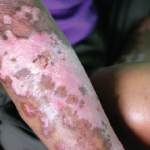Platelets contain high amounts of 5-hydroxytryptamine (5-HT) or serotonin. SSc patients have elevated levels of 5-HT in their blood, and this may be an important mediator of fibrosis in fibroblasts and mesangial cells, the study notes.6 In both humans and mice, 5-HT stimulates collagen release in fibroblasts, and mice deficient in 5-HT2B were protected from experimental skin fibrosis in one study.6 In other trials, nonselective 5-HT2 inhibitors terguride and cyproheptadine and the selective 5-HT2B inhibitor SB204741 both showed antifibrotic effects.7 In a small, non-blinded, proof-of-concept trial, SSc patients treated with terguride had lower modified Rodnan skin thickness scores (MRSSs) compared with untreated controls.8
There are other profibrotic mediators stored in human platelets, including growth factors—transforming growth factor β1 (TFGβ1), platelet-derived growth factor (PDGF), fibroblast growth factor (FGF) and vascular endothelial growth factor (VEGF)—and bioactive lipids, such as lysophosphatidic acid (LPA) and sphingosine 1-phosphate (S1P) receptor.9 Therapies targeting several of these factors are currently being studied, Dr. Distler says.
TFGβ1 is upregulated in SSc, and therapies that inhibit TGFβ signaling have been the subject of several studies. In one recent study of fresolimumab, a high-affinity neutralizing antibody that targets TGFβ isoforms, SSc patients showed MRSS decreases after one infusion of the drug, as well as reduced levels of mRNA for several TGFβ-related genes and decreased fibroblasts in fibrotic skin.10 In some studies, fresolimumab seemed to cause patients to develop high numbers of keratoacanthomas, or low-grade skin tumors, because TGFβ inhibits keratinocyte proliferation.11
Another possible target for SSc therapies is thrombin, which can induce the expression of profibrotic growth factors and is elevated in SSc patients. Dabigatran, a direct thrombin inhibitor, has shown antifibrotic effects in a bleomycin-induced lung fibrosis model and could show promise for both fibrosis prevention and treatment.12 Thromboxane A2 (TXA2) is also a possible target, because it may play a role in impaired angiogenesis in SSc. Anticoagulation therapy has been tested in patients with SSc-associated pulmonary arterial hypertension (PAH), but does not seem more effective than other therapies.13
Vitamin D receptor (VDR) is yet another regulator of fibrotic tissue responses, and SSc patients have decreased levels of this vitamin.14 VDR expression is down-regulated in SSc patients’ skin.15 VDR also regulates fibroblasts’ sensitivity to TGFβ’s profibrotic effects, and synthetic VDR agonists have reduced TGFβ’s stimulatory effects. VDR agonists studied in both preventive and therapeutic treatment of fibrosis have showed some early promise in mouse models.16
Innate Immune Response
In early SSc, patients often have inflammatory infiltrates that induce fibroblast activation and initiate tissue repair responses, says Dr. Distler. Recent research has shown that innate immune responses play an important role in SSc and other fibrotic diseases.17

